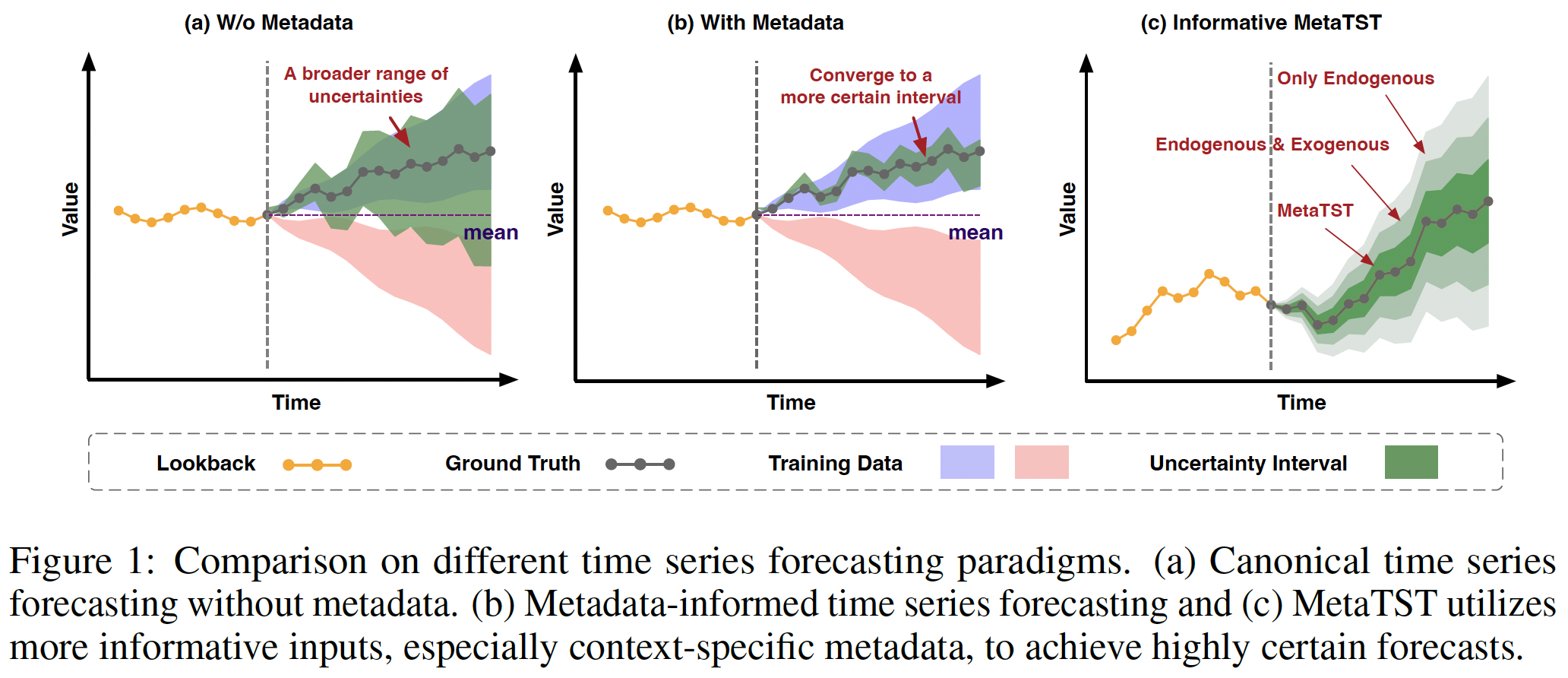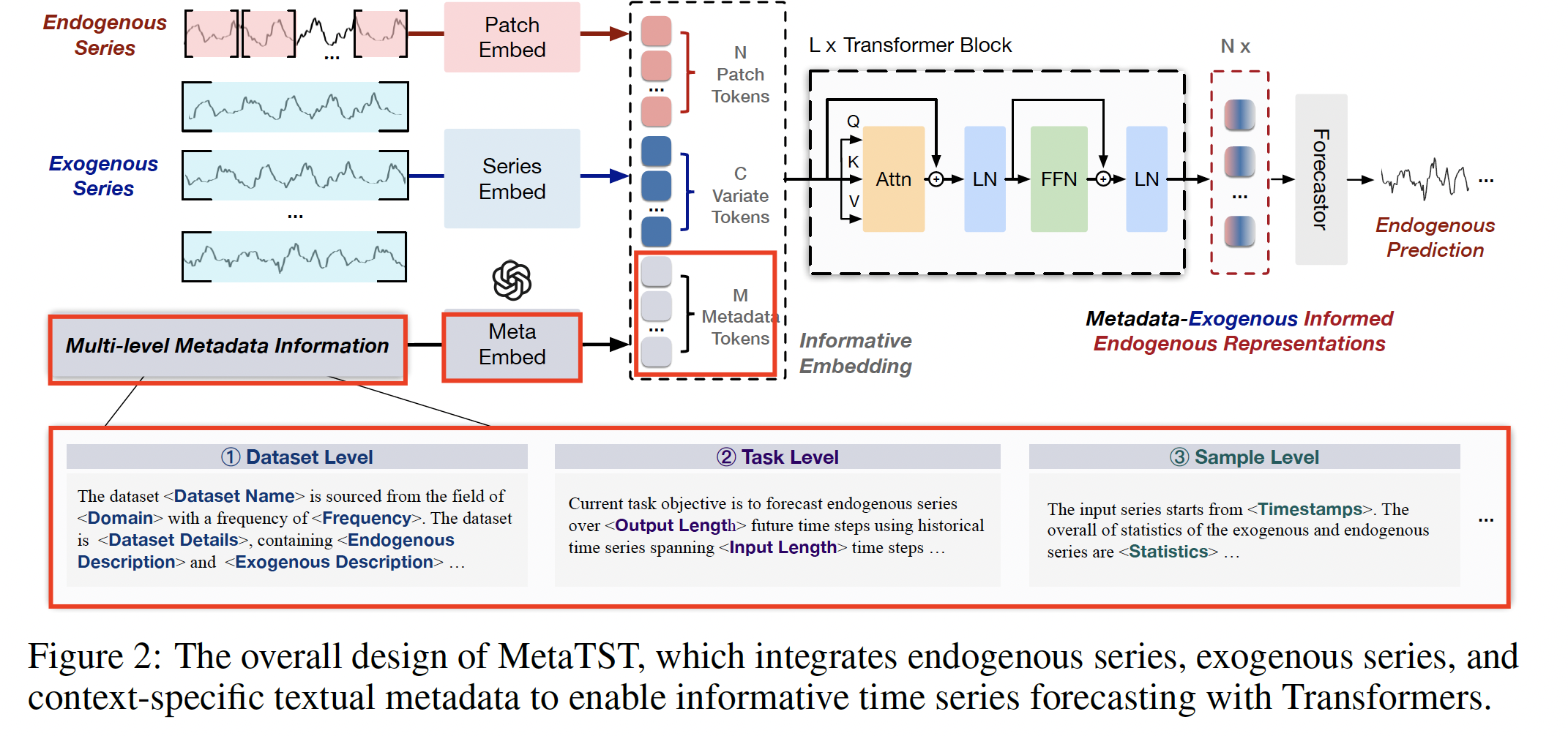Metadata Matters for Time Series; Informative Forecasting with Transformers
Contents
-
Abstract
-
Introduction
- Related Works
-
Finetuning LLMs
-
Freeze LLM, align TS data with NL
-
- Method
- Informative TS Forecasting
- Metadata Embedding
- MetaTST
0. Abstract
Metadata carries valuable information!
MetaTST
Metadata-informed Time Series Transformer
- incorporate multiple levels of context-specific metadata
- formalizes metadata into natrual languages (by predesigned templates)
- leverages LLMs to encode these texts into metadata tokens
Unlike previous LLM-TS models, use LLM as “fixed metadata encoder”
1. Introduction
Metadata
= descriptions about dtata
= data source details, statistical summaries ..
Characteristics of metadata
- usually unstructured
- contains information from heterogeneious views
Three key elements for accurate forecasting
- (1) Endogenous series
- (2) Exogenous series
- (3) Metadata

2. Related Works

LLM for TS
Briding gap between TS & Text
-
Fine-tuning LLMs
-
Freeze LLM, align TS data with NL
(1) Fine-tuning LLMs
- GPT4TS (2023): Fine-tune PE & LN in transformer (GPT2)
- LLM4TS (2023): Two stage fine-tuning to adapt LLMs to TS
(2) Freeze LLM, align TS data with NL
- TimeLLM (2024): Reprogram input TS with text prototypes
- AutoTime (2024): Independently embeds TS into latent space of LLM & train new projection layers for TS
Previous works takes LLM as “backbone” for prediction
\(\leftrightarrow\) MetaTST leverages LLM as “plug-in encoders” for context-specific metadata.
3. Method

(1) Informative Time Series Forecasting
Notation
- (1) Historical observations: \(\mathbf{x}_{\mathrm{en}} \in \mathbb{R}^{T_{\mathrm{en}}}\)
- (2) Relevant exogenous series: \(\mathbf{x}_{\mathrm{ex}}=\left\{\mathbf{x}_{\mathrm{ex}, 1}, \mathbf{x}_{\mathrm{ex}, 2}, \ldots, \mathbf{x}_{\mathrm{ex}, C}\right\} \in \mathbb{R}^{T_{\mathrm{ex}} \times C}\)
- (3) Corresponding metadata \(\mathbf{x}_{\text {meta }}\)
- Readily available in real-world applications,
Objective function
- \(\underset{\theta}{\arg \min } \mid \mid \mathbf{y}_{\mathrm{en}}-\mathcal{F}_\theta\left(\mathbf{x}_{\mathrm{en}}, \mathbf{x}_{\mathrm{ex}}, \mathbf{x}_{\mathrm{meta}}\right) \mid \mid _2^2\).
(2) Metadata Embedding
“Unstructured” metadata \(\rightarrow\) “Structured” NL template
- via Multi-level metadata parser
a) Multi-level Metadata parser
Three types of tokens to incorporate metadata
- (1) Dataset
- Essential properties about the dataset
- e.g., domian and sampling frequency
- (2) Task
- Description of the task
- e.g., target of interest, the length of input and output TS
- (3) Sample
- Dynamic statistics of TS
- e.g, start timestamps, mean, std …
\(\left\{\widehat{\mathbf{x}}_{\text {meta }, k}\right\}_{k=1}^M=\text { MetaParser }\left(\mathbf{x}_{\text {meta }}\right)\).
- \(M\): information levels, which is set as 3 (for dataset, task and sample aspects)
b) LLMs as the Metadata Encoder
(1) Any LLM can be used!
- e.g., auto-regressive LLMs (Llama, GPT), encoder-type LLMs (T5, BERT)
(2) Aggregtaion
- Word-level tokens \(\rightarrow\) Requires aggregation!

(3) Modality alignmnet module
\(\left\{\mathbf{h}_{\text {meta }, k}\right\}_{k=1}^M=\text { ModalAlign }\left(\left\{\widetilde{\mathbf{h}}_{\text {meta }, k}\right\}_{k=1}^M\right)\).
Summary
\[\left\{\mathbf{h}_{\text {meta }, k}\right\}_{k=1}^M=\operatorname{MetaEmbed}\left(\left\{\widehat{\mathbf{x}}_{\text {meta }, k}\right\}_{k=1}^M\right)\]-
Step 1) \(\left\{\widetilde{\mathbf{h}}_{\text {meta }, k}\right\}_{k=1}^M=\text { AvgPooling }\left(\text { LLMEncoder }\left(\left\{\widehat{\mathbf{x}}_{\text {meta }, k}\right\}_{k=1}^M\right)\right)\).
-
Step 2) \(\left\{\mathbf{h}_{\text {meta }, k}\right\}_{k=1}^M=\text { ModalAlign }\left(\left\{\widetilde{\mathbf{h}}_{\text {meta }, k}\right\}_{k=1}^M\right)\).
(3) MetaTST
Endogenous + Exogenous + Metadata
a) Informative Embedding
Endogenous
- (1) Splits the endogenous series \(\mathbf{x}_{\text {en }}\) into \(N=\left\lfloor\frac{T_{\mathrm{en}}}{P}\right\rfloor\)
- (2) Linear projection: endogenous token \(\mathbf{h}_{\mathrm{en}, i}\)
- with PatchEmbed \((\cdot): \mathbb{R}^P \rightarrow \mathbb{R}^D\).
- \(\left\{\mathbf{h}_{\mathrm{en}, i}\right\}_{i=1}^N=\operatorname{PatchEmbed}\left(\mathbf{x}_{\mathrm{en}}\right)\).
Exogenous
- Whole exogenous series \(\mathbf{x}_{\mathrm{ex}, j}\) into a \(D\)-dimensional exogenous token \(\mathbf{h}_{\mathrm{ex}, j}\).
- Variate-wise embedding SeriesEmbed \((\cdot): \mathbb{R}^{T_{\mathrm{cx}}} \rightarrow \mathbb{R}^D\)
- \(\left\{\mathbf{h}_{\mathrm{ex}, j}\right\}_{j=1}^C=\operatorname{SeriesEmbed}\left(\left\{\mathbf{x}_{\mathrm{ex}, j}\right\}_{j=1}^C\right)\).
Metadata token
- Have already been aligned to TS modality
Concatenation
- three types of tokens
- construct the informative embedding \(\mathbf{h}^0\), including
- (1) \(N\) patch-wise endogenous tokens
- (2) \(C\) series-wise exogenous tokens
- (3) \(M\) metadata tokens
- \(\mathbf{h}^0=\operatorname{Concat}\left(\left\{\mathbf{h}_{\mathrm{en}, i}\right\}_{i=1}^N,\left\{\mathbf{h}_{\mathrm{ex}, j}\right\}_{j=1}^C,\left\{\mathbf{h}_{\mathrm{meta}, k}\right\}_{k=1}^M\right)\).
b) Informative Forecasting
\(\mathbf{h}^{l+1}=\operatorname{TransformerBlock}\left(\mathbf{h}^l\right), l \in\{1, \cdots, L\}\).
\(\widehat{\mathbf{y}}_{\mathrm{en}}=\text { Forecastor }\left(\mathbf{h}_{\mathrm{en}}^L\right)\).
